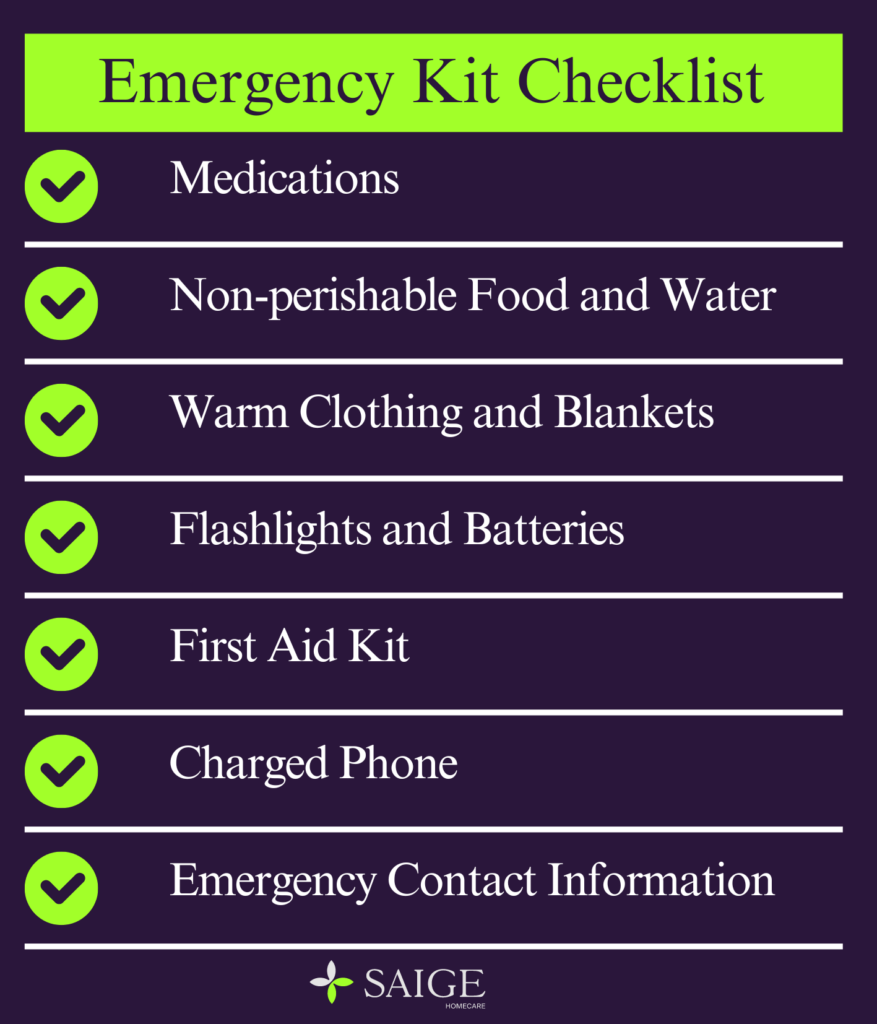As winter approaches, La Niña is expected to bring colder temperatures and heavier snowfall, leading to more than just inconveniences like slippery roads, extra shoveling, or increased heating costs. For those relying on home care services, the upcoming weather conditions could pose significant challenges.
Both clients and caregivers must anticipate potential disruptions and take proactive measures to ensure continuous and effective care during the fall and winter months. This article outlines the key challenges La Niña may bring and provides strategies to mitigate its impact.
What is La Niña?
La Niña is a weather pattern characterized by cooler ocean surface temperatures in the central and eastern Pacific Oceans. It typically lasts between nine months to two years and occurs every two to seven years. La Niña is part of the El Niño-Southern Oscillation (ENSO) climate pattern, which also includes El Niño.
In Canada, La Niña will likely bring these changes this fall and winter:
- Cooler Temperatures: Western Canada, especially the Prairies, may get cooler-than-normal weather, while eastern Canada could be warmer until October.
- More Precipitation: British Columbia, southern Alberta, and parts of Northern Canada may see more rain and snow, which could cause delays in-home care services.
- Stronger Storms: While fewer storms are expected, those that do occur may be stronger, especially on the coasts, leading to more rain and travel challenges for home care workers.
La Niña’s Impact on CDHC Services
La Niña’s extreme weather conditions, including winter storms and icy roads, could cause several disruptions to home care services. Below are some of the primary challenges that may arise:
Transportation Delays
La Niña can cause major transportation issues in Canada, especially in fall and winter. Heavy snow and ice, particularly in western Canada, create dangerous driving conditions, leading to delays and accidents. Caregivers may struggle to reach clients, especially in rural areas where severe weather frequently disrupts roads.
Snow and ice can also affect rail and air travel, leading to delays and cancellations as airports and railways deal with de-icing and snow removal. Increased precipitation can also damage infrastructure, causing road closures that make it even harder for caregivers to travel. These disruptions can leave vulnerable seniors without essential care when it’s needed most.
Increased Demand for Care
During extreme colds, seniors over 65 are at higher risk for health issues like frostbite, hypothermia, and respiratory illnesses such as flu and pneumonia. La Niña’s colder, wetter weather in northern areas worsens chronic conditions like arthritis and heart problems. The Government of Canada warns that health risks rise sharply when the wind chill hits -27°C, making extra care necessary.
Simple tasks like going outside or running errands become more dangerous, leading seniors to request more frequent help from home care providers. This extra demand strains already limited resources, as providers struggle to meet the need. In warmer, drier regions like the southern U.S., La Niña brings different challenges, such as dehydration and heat stress, particularly for seniors with existing health conditions.
Strain on Resources
La Niña adds extra challenges for home care providers already struggling with resource shortages due to the pandemic and an aging population. Severe weather raises health risks, increasing the demand for home care as seniors with chronic conditions need more frequent visits. Caregivers face burnout from longer shifts and heavier workloads while trying to meet the rising demand.
Staff shortages often get worse during cold and flu season, with more caregivers calling in sick. On top of this, power outages and disruptions to essential services caused by severe weather make it even harder to deliver consistent care to seniors at home.
Mental Health Challenges
In addition to physical challenges, La Niña’s colder weather and reduced daylight can bring emotional difficulties for seniors. Harsh winter conditions limit seniors’ mobility, increasing feelings of loneliness and anxiety.
The isolation experienced during winter months is particularly concerning for elderly clients, as social isolation can lead to depression. Seasonal Affective Disorder (SAD), a type of depression related to reduced sunlight in the winter, may also affect seniors.
Caregivers may need to give extra mental health support, especially for those already isolated due to health or mobility issues. The combined physical and emotional stress of La Niña highlights the need for strong support systems for both seniors and their caregivers.
Adapted Care Plans for Client-Directed Home Care During La Niña
In Calgary, extreme cold and snow caused by La Niña can make it difficult for caregivers to consistently reach clients. To address these challenges, home care services need to adapt quickly and ensure that seniors continue receiving the care they need, regardless of weather conditions.
Flexible Scheduling
Telehealth helps keep seniors safe during bad weather by allowing virtual medical visits. This means seniors get care without having to travel in dangerous conditions, reducing the risk of illnesses like the flu. Agencies should also reschedule in-person visits when the weather looks bad, using virtual check-ins to ensure seniors are still looked after when travel isn’t possible.
Emergency Preparedness
Preparing for emergencies is key during La Niña. Caregivers should make sure seniors and their homes are ready for sudden weather changes or power outages. Emergency kits with non-perishable food, water, medications, and blankets should be easily accessible. Homes should be winterized by checking heating systems and insulation. Snow must be cleared from driveways and pathways to prevent falls and ensure caregivers can access homes.
Technology Solutions
Telemedicine and remote health monitoring systems are invaluable tools during La Niña. By conducting virtual wellness checks, caregivers can assess seniors’ well-being without risking travel in hazardous conditions. Advanced health monitoring tools can track vital signs and other health data, helping caregivers spot problems early. This keeps seniors’ health monitored even when in-person visits are delayed.
Enhanced Caregiver Training
Training caregivers for emergencies during extreme weather is essential. They need to know how to spot issues like cold stress or heat exhaustion and act quickly to protect seniors. This training helps ensure safety in unpredictable conditions.
Caregivers should also be taught how to prepare homes for winter, making sure heating systems work and pathways are clear of snow and ice to prevent falls. These steps greatly reduce risks to seniors during harsh weather.
For example, consider programs like the Canadian Red Cross’s First Aid and CPR Training, which equip caregivers with vital skills to respond to emergencies. These training programs provide caregivers with essential knowledge to ensure the safety and well-being of their clients during extreme weather conditions.
Community and Family Support
Using local resources is crucial during extreme weather. Caregivers can work with community services like transportation, food delivery, and medical support to ensure seniors get what they need when regular care is disrupted. Local organizations, like the Calgary Homeless Foundation, offer vital help during winter months.
Family support is also important. Getting family members involved in caregiving, especially when professional visits are delayed, ensures seniors stay safe and cared for during emergencies. Families can fill gaps and provide extra support when needed.
Addressing Seasonal Affective Disorder (SAD) in Seniors
Seniors are more prone to SAD in winter due to less sunlight and isolation. Caregivers can help by encouraging time near windows or short outdoor walks for sunlight. When sunlight is limited, light therapy can mimic natural light and boost mood.
Indoor activities for seniors like puzzles, reading, or crafts keep seniors mentally engaged and reduce SAD symptoms. Having a daily routine gives them a sense of purpose, lowering the risk of depression. Caregivers should also offer emotional support, allowing seniors to share their feelings. If symptoms get worse, professional help may be needed for therapy or medication.
Encourage Healthy Lifestyle Choices
Promoting healthy lifestyle choices can also have a positive impact on mood. Caregivers can encourage seniors to eat a balanced diet with omega-3s, whole grains, and plenty of fruits and vegetables, as good nutrition is important for mental health.
Even light physical activities like stretching or yoga can lift mood by releasing endorphins. Keeping a regular sleep schedule is also crucial, as good sleep helps balance mood and energy levels.
By employing these strategies, caregivers can significantly mitigate the effects of SAD on their clients, fostering a supportive and nurturing environment during the challenging months of La Niña.
Local Support Services to Consider
Here are some valuable community resources that can provide essential assistance during challenging weather conditions.
Meal Delivery Programs
Services like Meals on Wheels ensure that clients receive nutritious meals delivered directly to their homes, even when caregivers are delayed or unavailable. These programs cater to dietary restrictions and preferences, promoting overall health. Additionally, regular check-ins by delivery personnel can provide reassurance to caregivers, knowing their clients are receiving proper nutrition and support.
Transportation Assistance
Community programs offering transportation assistance are essential for clients who need to attend medical appointments, social events, or run errands. These services may include volunteer drivers or subsidized rides through ride-sharing apps, ensuring clients remain mobile and independent. By utilizing these resources, caregivers can alleviate concerns about their clients’ transportation needs when they cannot provide assistance themselves.
Virtual Social Programs
Many senior centers now offer virtual social programs, enabling clients to participate in activities from the comfort of their homes. These online events can include exercise classes, art workshops, and game nights, promoting social interaction and engagement. By connecting with others in a virtual setting, clients can reduce feelings of isolation, enhancing their mental and emotional well-being during challenging times.
These resources can act as a safety net when regular services are disrupted, helping to fill the gaps created by La Niña’s harsh weather conditions.
Preparing for Emergencies During La Niña
Winter storms can temporarily disrupt care, so it’s important for clients to have an emergency kit ready. This will keep them safe and comfortable if a caregiver is delayed due to bad weather. To prepare for unexpected weather, here’s a simple checklist for an emergency kit.

By preparing an emergency kit in advance, clients can avoid unnecessary stress and ensure they have what they need to manage a short-term care disruption.
Training and Preparation for Caregivers During La Niña
Caregivers face unique challenges during La Niña, from navigating hazardous roads to managing care in emergencies. They must receive proper training to handle these difficulties and continue delivering safe, quality care.
- Winter Driving Safety: Caregivers should consider taking courses on safe driving in snow and icy conditions. This training helps them navigate dangerous roads, reducing the risk of accidents and ensuring they can reach clients safely.
- Emergency Care Protocols: Training in emergency preparedness is essential. Caregivers must know how to handle situations like power outages or severe storms, maintain effective communication, and provide necessary care to keep clients safe.
- Mental Health Awareness: Caregivers should be trained to recognize and support clients dealing with Seasonal Affective Disorder (SAD). Understanding its signs allows them to offer emotional support and address the psychological effects of winter.
Providing caregivers with these skills ensures they are equipped to manage the challenges of La Niña while continuing to deliver excellent care.
Prepare for La Niña’s Effects on CDHC
Preparing for La Niña’s effects is essential for both clients and caregivers. By addressing issues like transportation delays and increased care needs, we can maintain strong support during the colder months.
Utilizing community resources, creating emergency kits, and training caregivers will help us manage whatever winter brings. Together, we can ensure that care remains steady and reliable, even in tough times. Let’s face this winter-ready and resilient!
Related Reads
Addressing the Challenges of Long-Distance Caregiving in Calgary
Crеating a Dеmеntia-Friеndly Homе Environmеnt: Tips for Calgary Familiеs
FAQs on La Niña’s Impact on Client-Directed Home Care
Is La Niña good for winter?
La Niña can lead to colder, snowier winters in some regions, which may benefit winter sports enthusiasts. However, it can also cause harsh conditions and challenges for transportation and infrastructure.
Who is eligible for home care in Alberta?
Eligibility for home care in Alberta typically includes seniors, individuals with disabilities, or those recovering from illness or surgery. Assessments by health professionals determine specific needs and appropriate services.
What is the difference between El Niño and La Niña?
El Niño is characterized by warmer ocean temperatures in the central and eastern Pacific, leading to altered weather patterns, while La Niña features cooler ocean temperatures, typically resulting in opposite climatic effects.
How much does home care cost in Alberta?
Home care costs in Alberta vary based on service level and provider. On average, hourly rates range from $20 to $40, depending on the complexity of care required.
What should we do during La Niña?
During La Niña, prepare for potentially severe winter weather. Stock emergency supplies, ensure vehicles are winter-ready, stay informed about weather forecasts, and be proactive in winterizing homes to prevent damage.
What is involved in direct patient care?
Examples of direct patient care (DPC) tasks include measuring vital signs, assisting with bathing, helping patients transfer from bed to toilet or bedpan, assisting with walking, drawing blood, conducting diagnostic tests, administering prescribed therapies or treatments, and providing counseling.
What is not covered by Alberta Health Care for seniors?
Alberta’s Coverage for Seniors program does not include travel insurance. If you plan to travel outside of the province or country, it’s recommended to purchase additional travel insurance to cover any emergency hospital or medical expenses.


